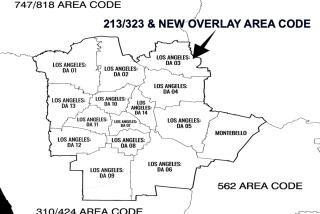An Overlay Is the Least Obtrusive Solution . . .
- Share via
Chaos! Corporate scheming! Doom! To hear some of the talk in the area code debate, there’s clearly no fate worse than punching four more buttons to make a phone call. Did someone say the world as we know it will end?
New telephone numbers in the 818 area code are projected to run out in 2001. The only methods available to create a pool of new numbers are a geographic split or an overlay. A split would divide the San Fernando Valley into two or more area codes. One would retain 818 and the others would be forced to change phone numbers. The overlay would create a second area code for the geographic area that 818 now covers. No one would have to change their number. But within 818, callers would be required to dial 11 digits--1 plus the area code and the telephone number--for all calls.
Although 11-digit dialing would require a change in habit, overlay relief remains the least obtrusive choice. With a geographic split, the negative effects are manifold.
Splits require thousands of businesses to reprint stationery, brochures and other material and to alter any electronic media that display telephone numbers. Overlays don’t. Splits isolate businesses from customers who may not know the new number. Overlays don’t.
The increased demand for new numbers that has helped fuel the need for area code changes is a result of new technologies, such as mobile phones, pagers, fax machines, automated teller machines and computer modems, and the passage of the 1996 Telecommunications Act. Congress’ intent in approving the act was to open the door to local competition. Competitors--and new wireless companies--must have telephone numbers available to go into business. And there are now more than 200 companies in California authorized to sell local phone service.
Public discussion of this issue has stirred emotions, but it has overlooked technical realities that guide how numbers are allocated and used by the phone companies. Although it’s conceivable that in 1947 AT&T; engineered the system with the precise intent of inconveniencing users in the year 2000, most contend that design was dictated by routing and billing efficiencies and Ohms’ law (a sinister little rule of physics dictating how far a signal can carry across a copper wire).
Telephone companies receive numbers in blocks of 10,000. Prefixes, the three numbers that follow an area code, are assigned by rate area. In the Valley, there are 16 rate areas. That’s why we associate the prefix 505 with North Hollywood, or 222 with Canoga Park. Each company requires numbers in every rate area in which it hopes to do business.
The California Public Utilities Commission says there are 180 million numbers available in the state and that only 37 million are in use. Although Pac Bell reports using more than 80% of the numbers assigned, new providers may use far fewer. Overlay opponents see this as hoarding on the part of the phone companies.
Although PUC accounting may indicate there are millions of numbers available in California, this doesn’t help the Valley. The fact that 555-8979 may be available in the 619 area code is irrelevent because 555-8979 already exists in 818. And within the Valley there may be many numbers available in Granada Hills, but they can’t be used in Studio City because the rate area--and consequently, the prefix--is different.
To increase number conservation, the Federal Communications Commission and the industry have been working on solutions, such as local number portability and the distribution of numbers in smaller, more manageable blocks of 1,000. An integrated approach could provide significant relief in many area codes. Number portability allows a user to keep a telephone number when switching providers within a rate area. (You wouldn’t get to keep the number if you moved across the Valley.)
Other proposals include requiring providers to return numbers not in use and assigning technology overlays, or separate area codes, to wireless devices.
Although combinations of these methods could delay 818 number exhaustion, they are not expected to prevent an overlay or split. The 818 area code went into prefix rationing in the last quarter of 1998. This means that numbers are distributed via lottery and not to all companies that need them. Under this system, customers may well be forced to pick the company lucky enough to have numbers instead of the company that has the best service, quality and price.
Allocating numbers to phone companies in 1,000-number blocks requires time, complex network changes and nationwide uniformity. The responsible approach now is for the PUC to expand the pool of numbers in 818 by 7.9 million numbers with an overlay so residential and business customers can get the numbers they need from the service providers they wish to use. It’s time to move beyond hysterical pronouncements and explore solutions that recognize consumers’ pocketbooks and the technological realities of a phone system that has worked pretty well for 50 years.






